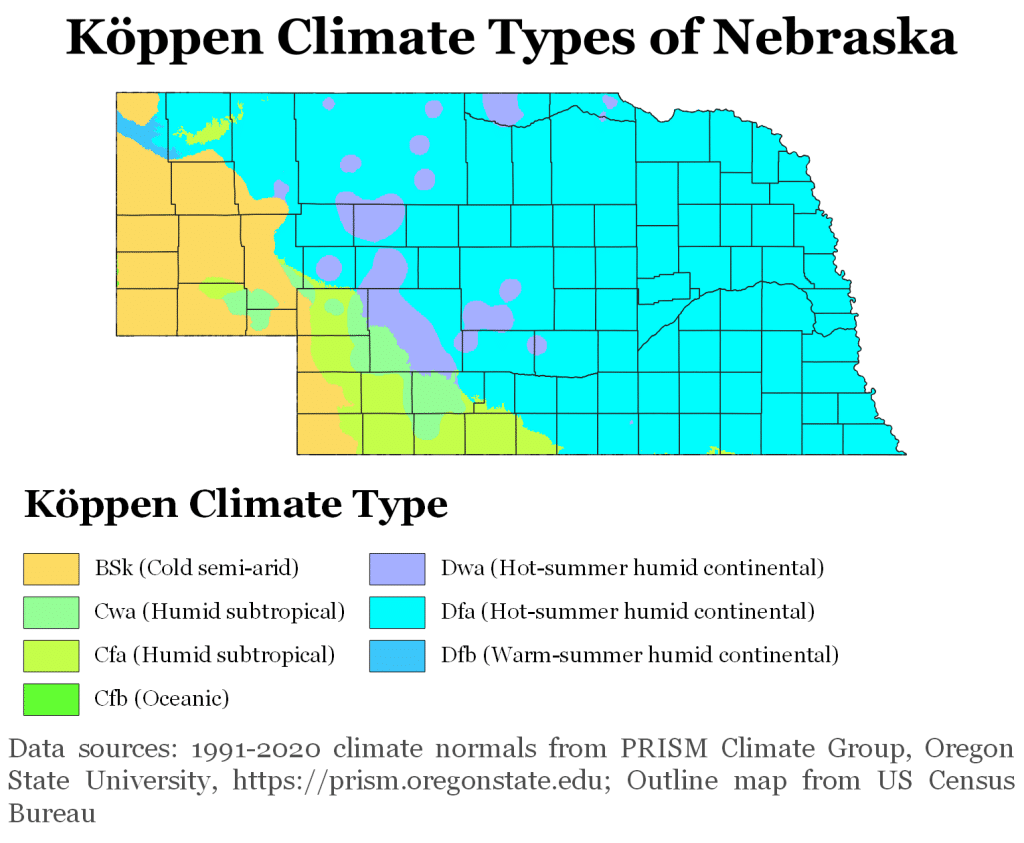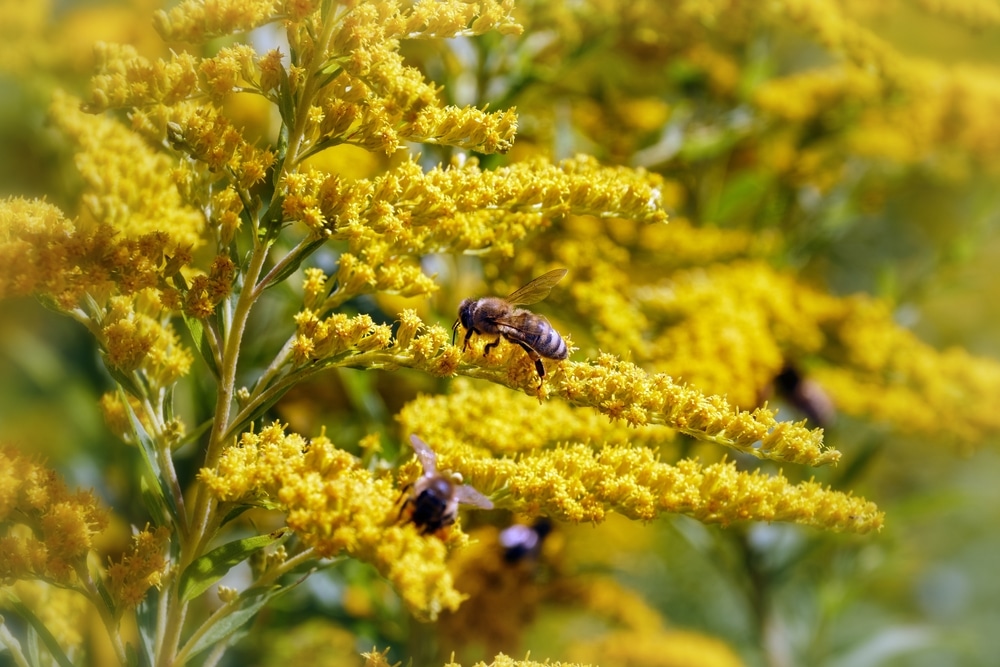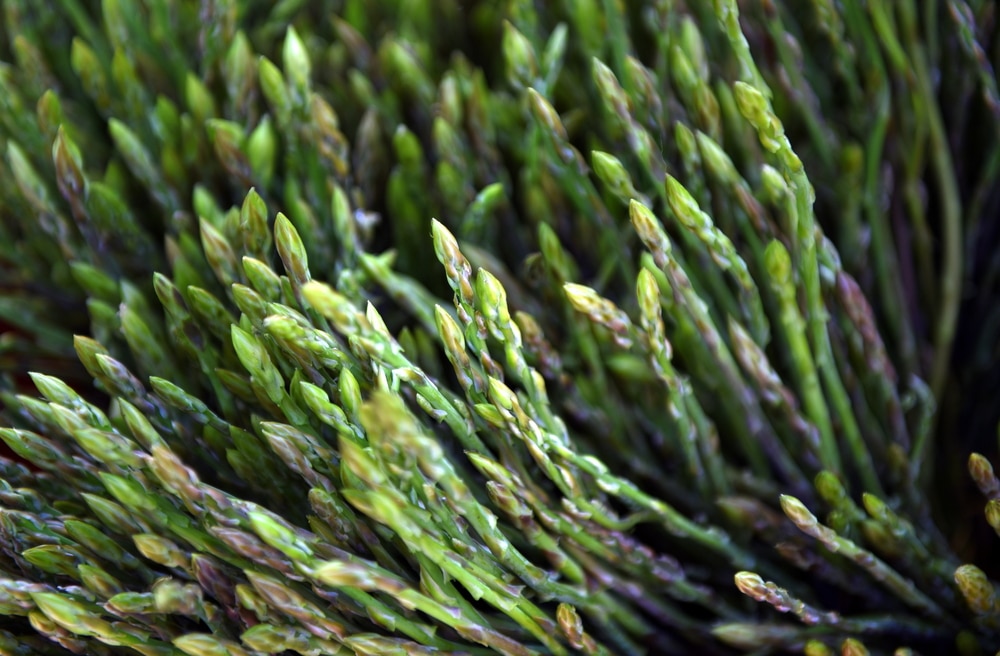Nebraska Plant Hardiness Zones
| USDA Hardiness Zone | Average Minimum Extreme Winter Temperature Range Fahrenheit (°F) Celsius (°C) | Average Last Frost Date Range In Spring (Beginning Of The Growing Season) | Average First Frost Date Range In Autumn (End Of The Growing Season) |
|---|---|---|---|
| 4b | -25°F to -20°F-31.7°C to -28.9°C | Mid to late May | Mid to late September |
| 5a | -20°F to -15°F-28.9°C to -26.1°C | Early to mid-May | Late September to early October |
| 5b | -15°F to -10°F -26.1°C to – 23.3°C | Early to mid-May | Late September to early October |
| 6a | -10°F to -5°F -23.3°C to 20.6°C | Late April to early May | Early to mid-October |
Nebraska Growing Conditions

Credit to Wikipedia
General Climate
Nebraska’s hardiness zones range from a cold 4b to 6a. The north experiences a colder climate while the southeast sees warmer weather.
The majority of Nebraska has a humid continental climate, the far southwest is humid subtropical, and the west has a semi-arid climate.
Semi-arid or steppe climates are the areas of land between deserts and mountainous regions. In areas like this, the amount of evaporation exceeds the amount of annual rainfall, thus making it a dry climate.
Humid continental climates have four distinct seasons, with large temperature fluctuations within each season. The summers are typically hot and the winters are typically cold.
The state is also split into two distinct land regions. The east is the Dissected Till Plains and the west is the Great Plains land region.
The Dissected Till Plains region is filled with rolling hills and fertile soil, making it great for growing. Whereas the Great Plains region has extensive treeless flatlands, mainly covered in prairies, grasslands, and steppe.
Microclimates
USDA plant hardiness zones are an important starting point for your garden, but you’ll also need to consider microclimates.
Microclimates are areas where specific conditions create a climate different from the climate they’re situated in.
Buildings, fences, paved areas, or short hills and valleys can create these microclimates.
They can be as small as a space in your backyard or as large as a city.
In other words, learn about your local conditions from local experts to see if your garden falls into a microclimate.
Extreme Weather
Thunderstorms
Nebraska experiences extreme thunderstorms from spring through summer, and occasionally in the fall. These storms bring high winds, hail, flooding, and even tornadoes.
Container gardening is a great way to help keep your favorite plants safe. In case of a storm you can bring your plants undercover, either in a garage, shed, or indoors. Then they are protected from the elements.
Chinook Winds
Chinook winds are present in Nebraska, typically occuring from winter through to early spring. These winds are warm and dry, often reaching high speeds. They blow from higher elevation mountainous regions into lower prairie lands and increase temperatures at a significant rate.
Chinook winds melt the snow, dry out the soil, and leave plants withered and wilted. This causes erosion, which can degrade habitat and leave the land bare.
To combat erosion, it is good to plant varieties of ground cover that have deep, strong root systems. Some choices are:
- Bearberry
- Creeping juniper
- Creeping phlox
These plants also help keep the ground moist and add beneficial nutrients to keep soil qualities thriving.
Growing Season
On average, Nebraska sees 130 days of frost-free growing. First and last frost depends on where you are located within the state. A longer growing season is enjoyed in the southeast, while the northwest sees a shorter growing season.
Nebraska is considered a cool climate with zones only reaching 6a. First frost dates range from mid-September to mid-October and last frost dates from late April to late May.
Cold hardy annuals are a great way to take advantage of a cooler climate. They add welcome color to your garden in the early growing months. Try planting cold hardy annual flowers such as:
- Larkspur
- Lupin
- Native wildflowers
Nebraska Gardening Tips

Xeriscape Gardening
Living in western Nebraska means living in an arid climate with flat prairies and grasslands. This means summers are dry and hot, with low precipitation.
When living in this climate, xeriscape gardening is a fun and low-maintenance way to still make a big impact in the garden.
Xeriscaping is a form of gardening that reduces the need of irrigation by using drought tolerant plants and grasses that survive well in hot climates.
Plant varieties that do well in xeriscape garden designs include:
- Cacti
- Mediterranean plants such as lavender
- Native wildflowers
- Grasses
Foraging For Edible Wild Plants
Nebraska has a wide range of edible native plants that have been used in traditional methods for eating and medicine by indigenous cultures for thousands of years. From fruits and seeds to wild veggies, there is an abundance of wild food available in this state.
It’s important to understand some key tips when foraging for wild edibles.
Proper Identification is one of the most important tips when foraging for wild food. It is best to have two separate identification books and really make sure you know what you are picking.
Sustainable Harvesting is important to keep native plants thriving. Key tips are:
- Don’t take the first plant you see
- Only take ⅓ of the plant
- Leave some for nature
Understanding foraging times is also important. Educate yourself on when is the best time to forage for certain plants. A good example of this is the stinging nettle. You have to harvest the new growth from this plant early in the season. If you wait too long (especially after flowering), the plant builds up high amounts of calcium carbonate that can affect kidney function.
It is important to research all plants when deciding what and when to forage.
Know the risks. Foraging can be fun and beneficial as long as you understand the risks of the activity. Stay safe and healthy while enjoying native edible plants!
Consult With Local Professionals
Consulting with local gardening professionals allows you to benefit from their experience with your area’s conditions, the plants that do well there, and overall best practices.
Nebraska Plant Suggestions

Trees
- Eastern Cottonwood (Populus deltoides)
- Eastern Redbud (Cercis canadensis)
- White Birch (Betula papyrifera)
Shrubs
- Lead Plant (Amorpha canescens)
- Downy Serviceberry (Amelanchier arborea)
- Sand Sagebrush (Artemisia filifolia)
Flowers
- Prairie Phlox (Phlox pilosa)
- Meadow Anemone (Amelanchier arborea)
- White Snakeroot (Ageratina altissima)
Vegetables
- Lady’s Leek (Allium cernuum)
- Prairie Turnip (Pediomelum esculentum)
- Wild Asparagus (Asparagus acutifolius)
Herbs
- Pineapple Weed (Matricaria discoidea)
- Wild Angelica (Angelica atropurpurea)
- Sweet Fern (Comptonia peregrina)
Spices
- Wild Vanilla (Galium triflorum)
- Wild Caraway (Carum carvi)
- Common Cow Parsnip (Heraculem maximum)
Fruits
- Pawpaw (Asimina triloba)
- Wild Plum (Prunus americana)
- American elderberry (Sambucus canadensis)
Succulents
- Nebraska Orange Cactus (Opuntia polyacantha)
- Purple Pincushion Cactus (Coryphantha vivipara)
- Ball Cactus (Opuntia fragilis)
Disclaimer
Any of the above can change and is not exhaustive.
Treat anything above like a good starter guide. Then use that as a foundation as you consult with local gardeners, professionals, forecasts, guides, and organizations.

